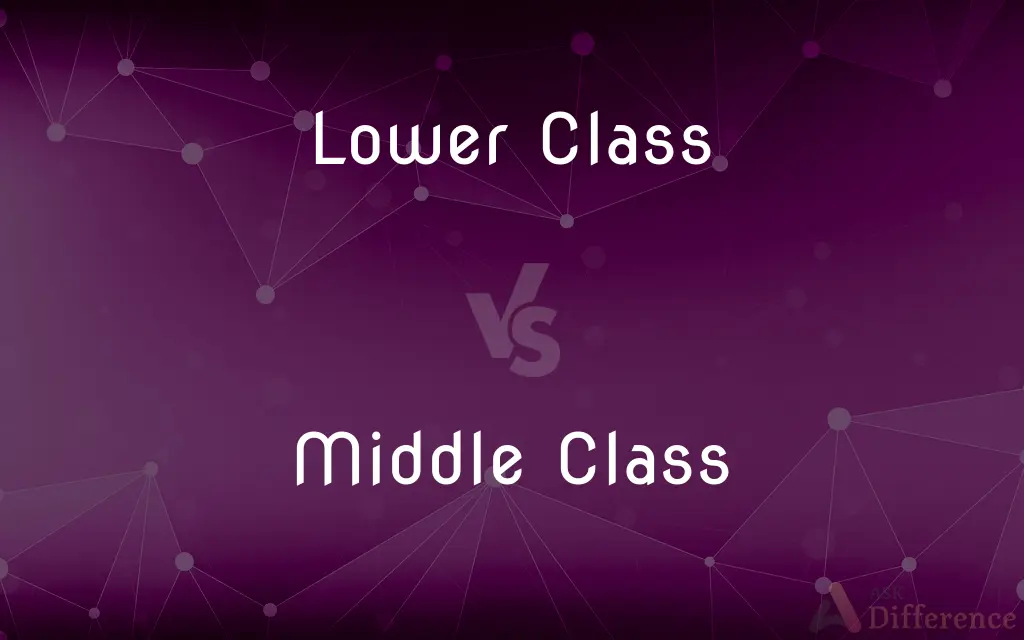Lower Class vs. Middle Class — What's the Difference?
By Tayyaba Rehman & Urooj Arif — Published on February 1, 2024
Lower Class refers to the socio-economic group with limited financial resources and opportunities. Middle Class signifies a socio-economic group with moderate income, stability, and higher educational access.

Difference Between Lower Class and Middle Class
Table of Contents
ADVERTISEMENT
Key Differences
The Lower Class typically encompasses individuals or families with minimal income, often struggling to meet basic needs. The Middle Class, in contrast, has a stable income that allows for a comfortable lifestyle, including owning property and savings.
Lower Class members often face limited access to quality education and healthcare due to financial constraints. Middle Class individuals usually have better access to these services, contributing to a more secure and stable lifestyle.
Employment in the Lower Class often involves manual labor, low-paying jobs, or unstable employment situations. The Middle Class commonly holds professional, administrative, or managerial positions that offer job security and benefits.
Lower Class individuals may rely on government assistance for basic needs and have limited opportunities for upward mobility. The Middle Class often enjoys more opportunities for career advancement and personal development.
Social mobility is typically more challenging for those in the Lower Class due to systemic barriers and lack of resources. The Middle Class, however, generally has more avenues for improving their socio-economic status through education and career opportunities.
ADVERTISEMENT
Comparison Chart
Income Level
Minimal, often below poverty line
Moderate, above poverty line
Access to Education
Limited, often lower quality
Better, higher education attainable
Employment Type
Manual labor, low-paying jobs
Professional, managerial positions
Lifestyle Stability
Often unstable
Generally stable and comfortable
Social Mobility
Limited opportunities
More opportunities for advancement
Compare with Definitions
Lower Class
Often faces challenges in accessing quality education.
Lower Class neighborhoods typically have underfunded schools.
Middle Class
Generally enjoys job security and benefits.
Middle Class individuals frequently work in office settings.
Lower Class
May rely on government assistance.
Many Lower Class individuals depend on food stamps.
Middle Class
A socio-economic group with moderate income.
Middle Class families often own their homes.
Lower Class
Characterized by limited financial resources.
The Lower Class is disproportionately affected during economic downturns.
Middle Class
Has access to quality education and healthcare.
Middle Class children usually attend well-funded schools.
Lower Class
Has limited employment opportunities.
Lower Class workers often have jobs with no benefits or job security.
Middle Class
Typically experiences stable lifestyles.
The Middle Class can afford annual family vacations.
Lower Class
A socio-economic group with minimal income.
Lower Class families often struggle to afford basic healthcare.
Middle Class
Often possesses savings and investments.
Many Middle Class people invest in retirement plans.
Lower Class
The socioeconomic class or classes of lower than middle rank in a society.
Middle Class
The socioeconomic class between the working class and the upper class, usually including professionals, highly skilled laborers, and lower and middle management.
Lower Class
Not of the elite, of the peasantry or working-class.
The lower-class people have little chance of advancement.
Middle Class
Occupying a position between the upper class and the working class.
Lower Class
Unrefined.
His lower-class tastes tended to run to three-stooges movies and cheap drink.
Middle Class
Of the middle class(es); reflective of that class's values and aspirations. Commonly associated with a desire for social respectability and an emphasis on family values and education.
Lower Class
Same as low-class. Contrasted with middle-class and upper-class.
Middle Class
Occupying the highest socioeconomic position in a society
Lower Class
Occupying the highest socioeconomic position in a society
Common Curiosities
What type of employment is common in the Middle Class?
Professional, administrative, or managerial positions.
What defines the Lower Class?
Limited income and financial resources, often below the poverty line.
How does education differ for the Lower Class?
They usually have limited access to quality education.
What is the Middle Class?
A socio-economic group with moderate income and stability.
Can Middle Class families afford higher education?
Yes, they generally have better access to higher education.
What is the lifestyle like for the Lower Class?
Often unstable, with struggles to meet basic needs.
How does healthcare access differ between these classes?
The Lower Class often faces challenges, while the Middle Class has better access.
Do Lower Class families often require government assistance?
Yes, many rely on assistance for basic needs.
What are typical jobs for the Lower Class?
Often manual labor or low-paying, unstable jobs.
What lifestyle is typical for the Middle Class?
Generally stable with comforts like home ownership.
Do Lower Class individuals have savings?
Typically, they have minimal to no savings.
Is social mobility easier for the Middle Class?
Yes, they have more opportunities for advancement.
How do housing conditions differ between these classes?
Lower Class may face inadequate housing, while Middle Class typically has better housing.
Are Middle Class individuals more likely to have investments?
Yes, they often have savings and investment plans.
Can Lower Class individuals move to the Middle Class?
It's possible, but often challenging due to systemic barriers.
Share Your Discovery

Previous Comparison
Balcony vs. Roof
Next Comparison
Full Virtualization vs. ParavirtualizationAuthor Spotlight
Written by
Tayyaba RehmanTayyaba Rehman is a distinguished writer, currently serving as a primary contributor to askdifference.com. As a researcher in semantics and etymology, Tayyaba's passion for the complexity of languages and their distinctions has found a perfect home on the platform. Tayyaba delves into the intricacies of language, distinguishing between commonly confused words and phrases, thereby providing clarity for readers worldwide.
Co-written by
Urooj ArifUrooj is a skilled content writer at Ask Difference, known for her exceptional ability to simplify complex topics into engaging and informative content. With a passion for research and a flair for clear, concise writing, she consistently delivers articles that resonate with our diverse audience.












































